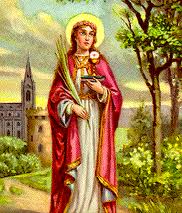Who is Saint-Barbara?
Barbara, the daughter of a rich pagan named Dioscorus, was carefully guarded by her father who kept her locked up in a tower in order to preserve her from the outside world. Having secretly become a Christian, she rejected an offer of marriage that she received through him.Before going on a journey, he commanded that a private bath-house be erected for her use near her dwelling, and during his absence, Barbara had three windows put in it, as a symbol of the Holy Trinity, instead of the two originally intended. When her father returned, she acknowledged herself to be a Christian; upon this he drew his sword to kill her, but her prayers created an opening in the tower wall and she was miraculously transported to a mountain gorge, where two shepherds watched their flocks. Dioscorus, in pursuit of his daughter, was rebuffed by the first shepherd, but the second betrayed her and was turned to stone and his flock changed to locusts.

Captured and tortured by Martinianus , the province prefect, Berbara held true to her faith. During the night, the dark prison was bathed in light and new miracles occurred. Every morning her wounds were healed. Torches that were to be used to burn her went out as soon as they came near her. Finally she was condemned to death by beheading. Her father himself carried out the death-sentence. However, as punishment for this, he was struck by lightning on the way home and his body was consumed by flame. Barbara was buried by a Christian, Valentinus, and her tomb became the site of miracles.
Our version of Eid Al Burbara
Saint Barbara's day or Eid Al-Burbara is celebrated annually on December 4 in Syria, Lebanon, Jordan and Palestine among Arab Christians. The traditional food for the occasion is Burbara, a bowl of boiled barley, pomegranate seeds, raisins, anise and sugar offered to masquerading children.
A special half-moon shaped sweet called Atayef is also prepared on this occasion in Lebanon. The two-bite pancake dessert is dough stuffed with nuts or clotted cream/Ashta and served with sugary syrup made of orange blossom water and Rose Water. Another dish prepared on Burbara is Kameh or Sneyniyeh. It is an Arabic dessert made from wheat boiled in anise-infused water, then sweetened and topped with nuts, raisins, and pomegranate seeds.
The general belief among Lebanese Christians is that Saint Barbara disguised herself in numerous characters to elude the Romans who were persecuting her.
Children go trick or treating while singing a special song for Eid Al-Burbara.
“Hechle Berbara ma3 banet el Hara Hechle Berbara wel Ame7 bel douawara
Arefta men Inayha w men lafit Idayha w men heik el Oswara
Thinkoun Bi Ziytkon Allah yaamir baytkon”
A common practice in Lebanon on Eid il-Burbara finds its source on the legend of Saint Barbara who was believed to witness a miracle while fleeing prosecution. She ran through freshly planted wheat fields, which grew instantly to cover her path. This miracle is recreated symbolically today by planting wheat seeds (or chick peas, barley grains, beans, lentils, etc.) in cotton wool on Saint Barbara’s feast day. The seeds germinate and grow up to around 6 inches in time for Christmas, when the shoots are used to decorate the nativity scene usually placed below the Christmas tree.